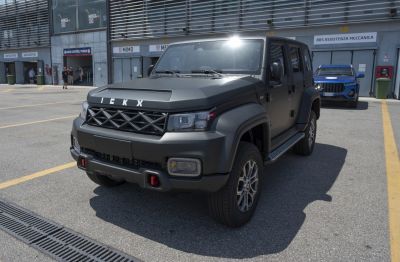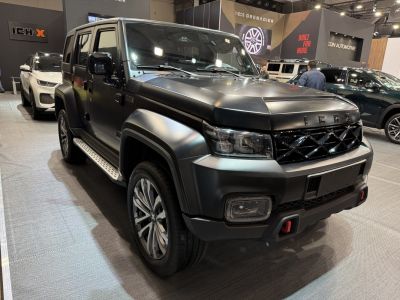 1997 Nissan Safari (Y61) Dimensions, Size & Specs
1997 Nissan Safari (Y61) Dimensions, Size & SpecsMeasurements of the 1997 Nissan Safari, engineered for optimal performance and comfort
| Dimensions | |
|---|---|
| Length: | 4340-4910 mm170.9-193.3 in14.2-16.1 ft |
| Width: | 1930 mm76.0 in6.3 ft |
| Height: | 1855-1865 mm73.0-73.4 in6.1-6.1 ft |
| Trunk Capacity: | 305-620 liter10.8-21.9 cu ft |
| Trunk Capacity (Max): | 1652-2226 liter58.3-78.6 cu ft |
| Weight Specifications | |
| Curb Weight: | 1850-2350 kg4079-5181 lbs |
| Maximal permitted Weight: | 2405-2920 kg5302-6437 lbs |
| Tire Specifications | |
| Rims Size: |
|
| Tire Size: |
|
The Nissan Safari Y61, produced between 1997 and 2002, is a robust off-road vehicle renowned for its versatility and rugged design. This generation of the Safari measures between 4340 mm to 4910 mm (approximately 170.9 to 193.3 inches) in length, with a consistent width of 1930 mm (75.9 inches), making it a substantial vehicle capable of handling demanding terrains while providing spacious interior accommodations. The height varies slightly from 1855 mm to 1865 mm (73.0 to 73.4 inches), contributing to a commanding road presence and improved ground clearance essential for off-road performance.
In terms of weight, the Safari Y61 ranges from 1850 kg to 2350 kg (4,078 to 5,181 lbs) curb weight, with a maximum weight capacity between 2405 kg and 2920 kg (5,300 to 6,437 lbs). This substantial weight range reflects different configurations and equipment levels, ensuring the vehicle can support heavy-duty use and passenger comfort. The luggage capacity ranges from 305 liters to 620 liters (10.8 to 21.9 cubic feet), providing adequate storage for daily and adventure use. With rear seats folded, the cargo space expands significantly, ranging from 1652 liters to 2226 liters (58.3 to 78.6 cubic feet), offering excellent versatility for larger loads or gear.
The Nissan Safari Y61 rides on 16-inch rims equipped with 265/70 R16 tires, a setup aimed at balancing off-road capability with on-road comfort and durability. These tires enhance traction and stability on rough terrains while maintaining performance on paved roads. The overall dimensions, combined with its rugged construction, make the Nissan Safari Y61 a dependable choice for enthusiasts who seek a capable SUV that can handle off-road excursions without sacrificing everyday usability.
Discover the standout features that make the 1997 Nissan Safari a leader in its class
Have a question? Please check our knowledgebase first.
The Nissan Safari (Y61) produced between 1997 and 2002 varies in length from 4340 mm to 4910 mm (approximately 170.9 to 193.3 inches). This variation depends on specific models and configurations within the Y61 generation. The longer length versions typically correspond to models with extended wheelbase or additional equipment, which enhances interior space and off-road capability. This length range situates the Safari comfortably in the full-size off-road vehicle category, providing ample space for passengers and cargo without being excessively large for rough terrain.
The Nissan Safari (Y61) has a fixed width of 1930 mm (about 76 inches). This width offers a stable stance that enhances vehicle stability and handling, especially during off-road driving on uneven or slippery surfaces. A wider vehicle footprint helps reduce the risk of tipping or rolling over when negotiating steep slopes or rocky terrain. However, this also means it requires adequate clearance when navigating narrow trails or tighter spaces, necessitating cautious driving in constrained environments.
The Nissan Safari (Y61) stands between 1855 mm and 1865 mm (approximately 73 to 73.4 inches) in height. This elevated profile improves ground clearance, critical for off-road performance by allowing the vehicle to pass over obstacles such as rocks, tree roots, and uneven terrain without damage to the undercarriage. Additionally, the height provides better visibility for the driver and increased interior headroom for passengers, contributing to both safety and comfort during off-road adventures.
The Nissan Safari (Y61) weighs between 1850 kg and 2350 kg (about 4082 to 5181 lbs) at curb weight, depending on equipment and model variants. Its maximum permissible weight ranges from 2405 kg to 2920 kg (approximately 5300 to 6435 lbs). The substantial weight contributes to a solid and stable driving experience, enhancing traction on loose surfaces like sand or gravel. However, heavier weight can affect fuel efficiency and agility. The capacity to carry heavy loads or tow additional gear makes the Safari especially practical for expeditions and off-road utility.
The Nissan Safari (Y61) offers a luggage capacity ranging from 305 liters to 620 liters (roughly 10.8 to 21.9 cubic feet) with rear seats in place, accommodating typical cargo like luggage or outdoor equipment. When the rear seats are folded down, this capacity significantly expands to between 1652 liters and 2226 liters (about 58.3 to 78.6 cubic feet), allowing for transport of larger items or increased volume of gear. This flexibility makes the Safari well suited for both passenger transport and hauling bulky off-road or camping supplies.
The Nissan Safari (Y61), with a length ranging from 4340 mm to 4910 mm (170.9 to 193.3 inches), a width of 1930 mm (76 inches), and height of approximately 1855 mm to 1865 mm (73 to 73.4 inches), may present fitting challenges in some standard residential garages. Standard garages typically measure about 6 meters (20 feet) in length and 2.4 to 2.7 meters (8 to 9 feet) in width. While width and height are generally manageable, the upper range of the Safari's length at 4.9 meters (16.1 feet) is close to typical garage length limits, meaning larger models or ones with accessories like roof racks might require a slightly larger garage or might extend into the driveway.
Compared to its predecessor, the Nissan Safari Y60 generation, the Y61 introduced from 1997 to 2002 generally maintained a similar footprint but featured enhancements in comfort, technology, and safety rather than drastic dimensional changes. The Y61 tended to offer improved interior space utilization with increased luggage capacity, better suspension for off-road performance, and upgraded interior amenities. The dimensions show slight variation but largely retain the full-size off-road vehicle proportions. The Y61 was developed to be more refined while retaining the ruggedness and off-road capability that the Safari line is known for.
When compared to similar full-size off-road SUVs from the late 1990s and early 2000s, such as the Toyota Land Cruiser 80 series and the Mitsubishi Pajero, the Nissan Safari (Y61) stands out with its substantial weight and competitive cargo capacities. Its length and width are comparable, with lengths around 4.3 to 4.9 meters and width near 1.93 meters, which makes it slightly wider but similarly long as competitors. The Safari's luggage volume (up to 2226 liters with seats folded) is on par with or exceeds many rivals, reflecting a strong emphasis on interior versatility and utility. Its curb and maximum weights are typical for full-size off-roaders, balancing durability with practical payload.
The Nissan Safari (Y61) typically comes equipped with 16-inch rims and tires sized 265/70 R16. The 16-inch rim size offers a good balance between rugged tire sidewall height and wheel strength, which is essential for absorbing shocks from rough terrain. The 265 mm wide tire provides a broad contact patch for enhanced traction on loose surfaces such as mud, sand, and rocks. The 70 profile (aspect ratio) gives the tires a taller sidewall, which improves ride comfort and allows for better flexing over obstacles, critical for off-road durability and maintaining traction.
The Nissan Safari (Y61) is known for its robust off-road capabilities, including advanced suspension systems tailored for rough terrain, improved four-wheel-drive configurations, and increased payload capacity. Compared to older generations, the Y61 integrated more modern technologies such as enhanced locking differentials, optional electronic traction aids, and better engine options that combined power with fuel efficiency. These improvements made it more adept at handling extreme off-road conditions such as steep inclines, rocky trails, and deep sand. Moreover, driver comfort and safety features were upgraded, making the Y61 a versatile vehicle for both adventure and everyday use.
Discover similar sized cars.

| Production: | 2022-2024 |
|---|---|
| Model Year: | 2022 |
| Length: | 4645 mm182.9 in |
| Width: | 1925 mm75.8 in |
| Height: | 1871 mm73.7 in |

| Production: | 2024-present |
|---|---|
| Model Year: | 2024 |
| Length: | 4645 mm182.9 in |
| Width: | 1925 mm75.8 in |
| Height: | 1871 mm73.7 in |
